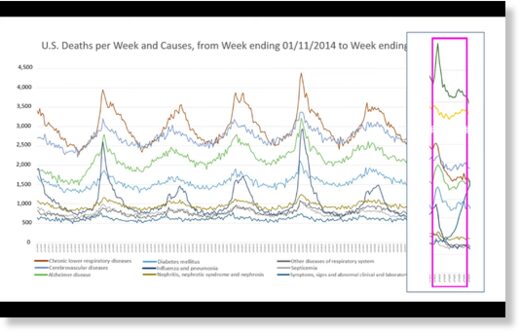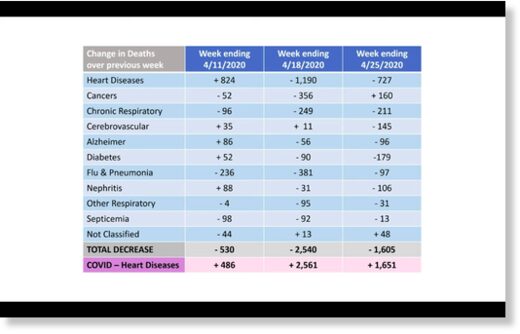- After 10 months of global panic,Johns Hopkins' experts have confirmed that there is, in their own words, "no evidence that COVID-19 created any excess deaths" in 2020.
- Surprisingly, the deaths of older people stayed the same before and after COVID-19.
- Since COVID-19 mainly affects the elderly, experts expected an increase in the percentage of deaths in older age groups.
Johns Hopkins University Reveals Manipulated Covid Death Figures
Yanni Gu
Johns Hopkins University
Sun, 22 Nov 2020 07:14 UTC
Comment: The following article was published in the Johns Hopkins University newsletter on November 22nd. It has since been taken down, so we're archiving it on Sott.net.
This university has been 'Covid-19 central' for data collection and analysis for all countries globally from the get-go. After 10 months of global panic, its experts have confirmed that there is, in their own words, "no evidence that COVID-19 created any excess deaths" in 2020.
In short, this has all been for nothing.
After retrieving data on the CDC website, Briand compiled a graph representing percentages of total deaths per age category from early February to early September.
From mid-March to mid-September, U.S. total deaths have reached 1.7 million, of which 200,000, or 12% of total deaths, are COVID-19-related. Instead of looking directly at COVID-19 deaths, Briand focused on total deaths per age group and per cause of death in the U.S. and used this information to shed light on the effects of COVID-19.
She explained that the significance of COVID-19 on U.S. deaths can be fully understood only through comparison to the number of total deaths in the United States.
After retrieving data on the CDC website, Briand compiled a graph representing percentages of total deaths per age category from early February to early September, which includes the period from before COVID-19 was detected in the U.S. to after infection rates soared.
Surprisingly, the deaths of older people stayed the same before and after COVID-19...
Since COVID-19 mainly affects the elderly, experts expected an increase in the percentage of deaths in older age groups. However, this increase is not seen from the CDC data. In fact, the percentages of deaths among all age groups remain relatively the same.
"The reason we have a higher number of reported COVID-19 deaths among older individuals than younger individuals is simply because every day in the U.S. older individuals die in higher numbers than younger individuals," Briand said.
Briand also noted that 50,000 to 70,000 deaths are seen both before and after COVID-19, indicating that this number of deaths was normal long before COVID-19 emerged. Therefore, according to Briand, not only has COVID-19 had no effect on the percentage of deaths of older people, but it has also not increased the total number of deaths.
These data analyses suggest that in contrast to most people's assumptions, the number of deaths by COVID-19 is not alarming. In fact, it has relatively no effect on deaths in the United States.
This comes as a shock to many people. How is it that the data lie so far from our perception?
To answer that question, Briand shifted her focus to the deaths per causes ranging from 2014 to 2020. There is a sudden increase in deaths in 2020 due to COVID-19. This is no surprise because COVID-19 emerged in the U.S. in early 2020, and thus COVID-19-related deaths increased drastically afterward.
Analysis of deaths per cause in 2018 revealed that the pattern of seasonal increase in the total number of deaths is a result of the rise in deaths by all causes, with the top three being heart disease, respiratory diseases, influenza and pneumonia.
"This is true every year. Every year in the U.S. when we observe the seasonal ups and downs, we have an increase of deaths due to all causes," Briand pointed out.
When Briand looked at the 2020 data during that seasonal period, COVID-19-related deaths exceeded deaths from heart diseases. This was highly unusual since heart disease has always prevailed as the leading cause of deaths.
This trend is completely contrary to the pattern observed in all previous years. Interestingly, as depicted in the table below, the total decrease in deaths by other causes almost exactly equals the increase in deaths by COVID-19. This suggests, according to Briand, that the COVID-19 death toll is misleading. Briand believes that deaths due to heart diseases, respiratory diseases, influenza and pneumonia may instead be recategorized as being due to COVID-19.
The CDC classified all deaths that are related to COVID-19 simply as COVID-19 deaths. Even patients dying from other underlying diseases but are infected with COVID-19 count as COVID-19 deaths. This is likely the main explanation as to why COVID-19 deaths drastically increased while deaths by all other diseases experienced a significant decrease.
"All of this points to no evidence that COVID-19 created any excess deaths. Total death numbers are not above normal death numbers. We found no evidence to the contrary," Briand concluded.
In an interview with The News-Letter, Briand addressed the question of whether COVID-19 deaths can be called misleading since the infection might have exacerbated and even led to deaths by other underlying diseases.
"If [the COVID-19 death toll] was not misleading at all, what we should have observed is an increased number of heart attacks and increased COVID-19 numbers. But a decreased number of heart attacks and all the other death causes doesn't give us a choice but to point to some misclassification," Briand replied.
In other words, the effect of COVID-19 on deaths in the U.S. is considered problematic only when it increases the total number of deaths or the true death burden by a significant amount in addition to the expected deaths by other causes. Since the crude number of total deaths by all causes before and after COVID-19 has stayed the same, one can hardly say, in Briand's view, that COVID-19 deaths are concerning.
Briand also mentioned that more research and data are needed to truly decipher the effect of COVID-19 on deaths in the United States.
Throughout the talk, Briand constantly emphasized that although COVID-19 is a serious national and global problem, she also stressed that society should never lose focus of the bigger picture — death in general.
The death of a loved one, from COVID-19 or from other causes, is always tragic, Briand explained. Each life is equally important and we should be reminded that even during a global pandemic we should not forget about the tragic loss of lives from other causes.
According to Briand, the over-exaggeration of the COVID-19 death number may be due to the constant emphasis on COVID-19-related deaths and the habitual overlooking of deaths by other natural causes in society.
During an interview with The News-Letter after the event, Poorna Dharmasena, a master's candidate in Applied Economics, expressed his opinion about Briand's concluding remarks.
"At the end of the day, it's still a deadly virus. And over-exaggeration or not, to a certain degree, is irrelevant," Dharmasena said.
Comment: In case you were wondering, yes, this guy is an idiot.
When asked whether the public should be informed about this exaggeration in death numbers, Dharmasena stated that people have a right to know the truth. However, COVID-19 should still continuously be treated as a deadly disease to safeguard the vulnerable population.
https://www.sott.net/article/444898-Johns-Hopkins-University-Reveals-Manipulated-Covid-Death-Figures
____
A closer look at U.S. deaths due to COVID-19
Editor’s Note: After The News-Letter published this article on Nov. 22, it was brought to our attention that our coverage of Genevieve Briand’s presentation “COVID-19 Deaths: A Look at U.S. Data” has been used to support dangerous inaccuracies that minimize the impact of the pandemic.
We decided on Nov. 26 to retract this article to stop the spread of misinformation, as we noted on social media. However, it is our responsibility as journalists to provide a historical record. We have chosen to take down the article from our website, but it is available here as a PDF.
In accordance with our standards for transparency, we are sharing with our readers how we came to this decision. The News-Letter is an editorially and financially independent, student-run publication. Our articles and content are not endorsed by the University or the School of Medicine, and our decision to retract this article was made independently.
Briand’s study should not be used exclusively in understanding the impact of COVID-19, but should be taken in context with the countless other data published by Hopkins, the World Health Organization and the Centers for Disease Control and Prevention (CDC).
As assistant director for the Master’s in Applied Economics program at Hopkins, Briand is neither a medical professional nor a disease researcher. At her talk, she herself stated that more research and data are needed to understand the effects of COVID-19 in the U.S.
Briand was quoted in the article as saying, “All of this points to no evidence that COVID-19 created any excess deaths. Total death numbers are not above normal death numbers.”
This claim is incorrect and does not take into account the spike in raw death count from all causes compared to previous years. According to the CDC, there have been almost 300,000 excess deaths due to COVID-19. Additionally, Briand presented data of total U.S. deaths in comparison to COVID-19-related deaths as a proportion percentage, which trivializes the repercussions of the pandemic. This evidence does not disprove the severity of COVID-19; an increase in excess deaths is not represented in these proportionalities because they are offered as percentages, not raw numbers.
Briand also claimed in her analysis that deaths due to heart diseases, respiratory diseases, influenza and pneumonia may be incorrectly categorized as COVID-19-related deaths. However, COVID-19 disproportionately affects those with preexisting conditions, so those with those underlying conditions are statistically more likely to be severely affected and die from the virus.
Because of these inaccuracies and our failure to provide additional information about the effects of COVID-19, The News-Letter decided to retract this article. It is our duty as a publication to combat the spread of misinformation and to enhance our fact-checking process. We apologize to our readers.
https://www.jhunewsletter.com/article/2020/11/a-closer-look-at-u-s-deaths-due-to-covid-19
__




Ei kommentteja:
Lähetä kommentti
You are welcome to show your opinion here!